If you were asked to name three key components of Microsoft Excel, what would they be? Most likely, spreadsheets to input data, formulas to perform calculations and charts to create graphical representations of various data types.
I believe, every Excel user knows what a chart is and how to create it. However, one graph type remains opaque to many - the Gantt chart. This short tutorial will explain the key features of the Gantt diagram, show how to make a simple Gantt chart in Excel, where to download advanced Gantt chart templates and how to use the online Project Management Gantt Chart creator.
What is a Gantt chart?
The Gantt chart bears a name of Henry Gantt, American mechanical engineer and management consultant who invented this chart as early as in 1910s. A Gantt diagram in Excel represents projects or tasks in the form of cascading horizontal bar charts. A Gantt chart illustrates the breakdown structure of the project by showing the start and finish dates as well as various relationships between project activities, and in this way helps you track the tasks against their scheduled time or predefined milestones.

How to make Gantt chart in Excel
Regrettably, Microsoft Excel does not have a built-in Gantt chart template as an option. However, you can quickly create a Gantt chart in Excel by using the bar graph functionality and a bit of formatting.
Please follow the below steps closely and you will make a simple Gantt chart in under 3 minutes. We will be using Excel 2010 for this Gantt chart example, but you can simulate Gantt diagrams in any version of Excel 2013 through Excel 365 in the same way.
1. Create a project table
You start by entering your project's data in an Excel spreadsheet. List each task is a separate row and structure your project plan by including the Start date, End date and Duration, i.e. the number of days required to complete the tasks.
Tip. Only the Start date and Duration columns are necessary for creating an Excel Gantt chart. If you have Start Dates and End Dates, you can use one of these simple formulas to calculate Duration, whichever makes more sense for you:
Duration = End Date - Start Date
Duration = End date - Start date + 1
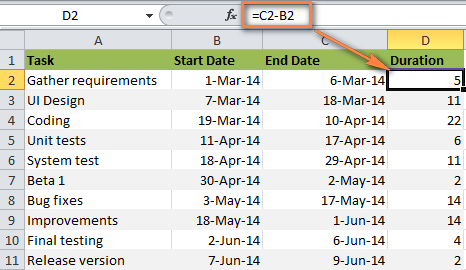
2. Make a standard Excel Bar chart based on Start date
You begin making your Gantt chart in Excel by setting up a usual Stacked Bar chart.
- Select a range of your Start Dates with the column header, it's B1:B11 in our case. Be sure to select only the cells with data, and not the entire column.
- Switch to the Insert tab > Charts group and click Bar.
- Under the 2-D Bar section, click Stacked Bar.

As a result, you will have the following Stacked bar added to your worksheet:
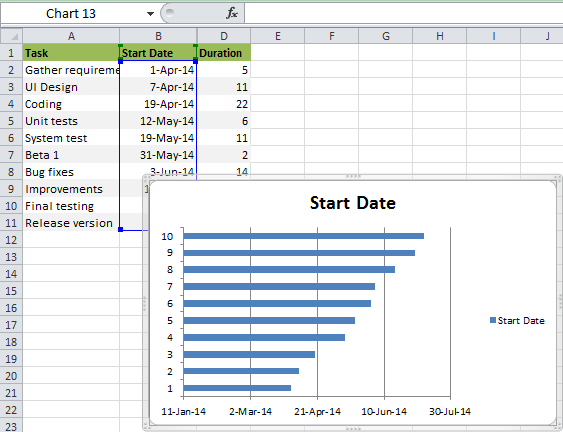
Note. Some other Gantt Chart tutorials you can find on the web recommend creating an empty bar chart first and then populating it with data as explained in the next step. But I think the above approach is better because Microsoft Excel will add one data series to the chart automatically, and in this way save you some time.
3. Add Duration data to the chart
Now you need to add one more series to your Excel Gantt chart-to-be.
- Right-click anywhere within the chart area and choose Select Data from the context menu.
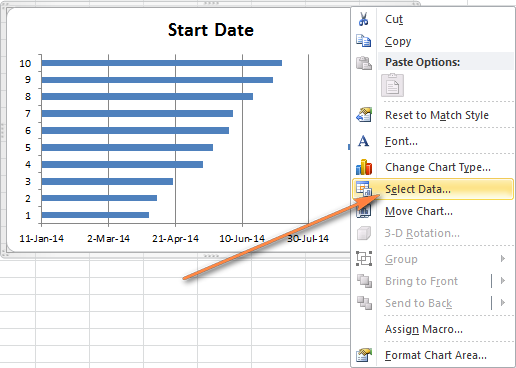 The Select Data Source window will open. As you can see in the screenshot below, Start Date is already added under Legend Entries (Series). And you need to add Duration there as well.
The Select Data Source window will open. As you can see in the screenshot below, Start Date is already added under Legend Entries (Series). And you need to add Duration there as well. - Click the Add button to select more data (Duration) you want to plot in the Gantt chart.
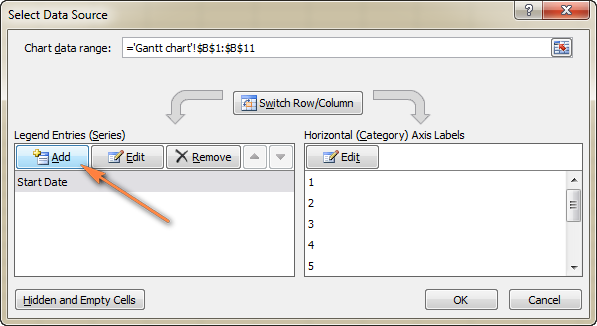
- The Edit Series window opens and you do the following:
- In the Series name field, type "Duration" or any other name of your choosing. Alternatively, you can place the mouse cursor into this field and click the column header in your spreadsheet, the clicked header will be added as the Series name for the Gantt chart.
- Click the range selection icon
 next to the Series Values field.
next to the Series Values field.

- A small Edit Series window will open. Select your project Duration data by clicking on the first Duration cell (D2 in our case) and dragging the mouse down to the last duration (D11). Make sure you have not mistakenly included the header or any empty cell.
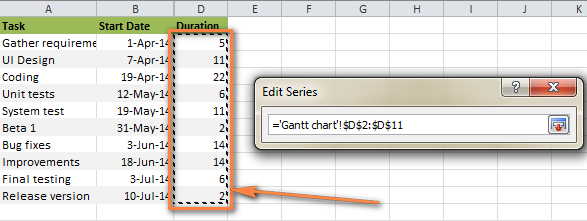
- Click the Collapse Dialog icon to exit this small window. This will bring you back to the previous Edit Series window with Series name and Series values filled in, where you click OK.
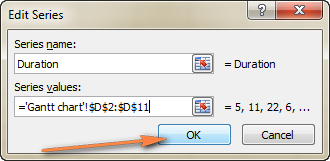
- Now you are back at the Select Data Source window with both Start Date and Duration added under Legend Entries (Series). Simply click OK for the Duration data to be added to your Excel chart.
 The resulting bar chart should look similar to this:
The resulting bar chart should look similar to this:
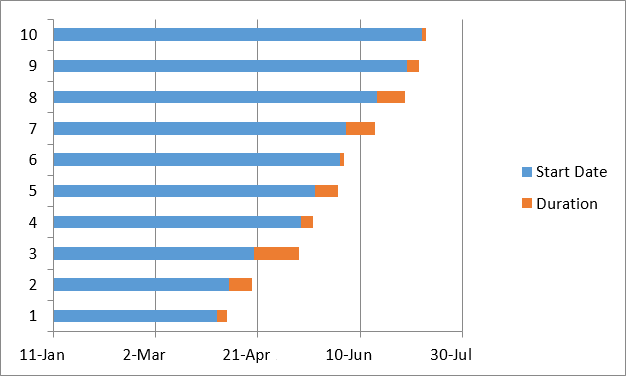
4. Add task descriptions to the Gantt chart
Now you need to replace the days on the left side of the chart with the list of tasks.
- Right-click anywhere within the chart plot area (the area with blue and orange bars) and click Select Data to bring up the Select Data Source window again.
- Make sure the Start Date is selected on the left pane and click the Edit button on the right pane, under Horizontal (Category) Axis Labels.

- A small Axis Label window opens and you select your tasks in the same fashion as you selected Durations in the previous step - click the range selection icon
 , then click on the first task in your table and drag the mouse down to the last task. Remember, the column header should not be included. When done, exit the window by clicking on the range selection icon again.
, then click on the first task in your table and drag the mouse down to the last task. Remember, the column header should not be included. When done, exit the window by clicking on the range selection icon again.

- Click OK twice to close the open windows.
- Remove the chart labels block by right-clicking it and selecting Delete from the context menu.
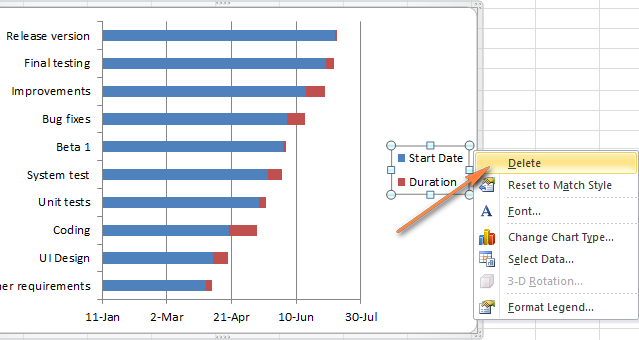 At this point your Gantt chart should have task descriptions on the left side and look something like this:
At this point your Gantt chart should have task descriptions on the left side and look something like this:
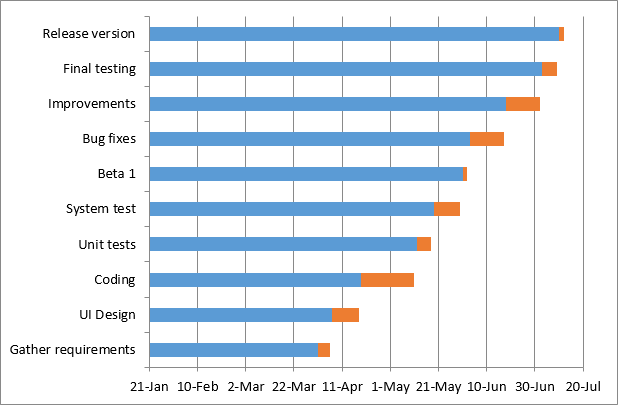
5. Transform the bar graph into the Excel Gantt chart
What you have now is still a stacked bar chart. You have to add the proper formatting to make it look more like a Gantt chart. Our goal is to remove the blue bars so that only the orange parts representing the project's tasks will be visible. In technical terms, we won't really delete the blue bars, but rather make them transparent and therefore invisible.
- Click on any blue bar in your Gantt chart to select them all, right-click and choose Format Data Series from the context menu.
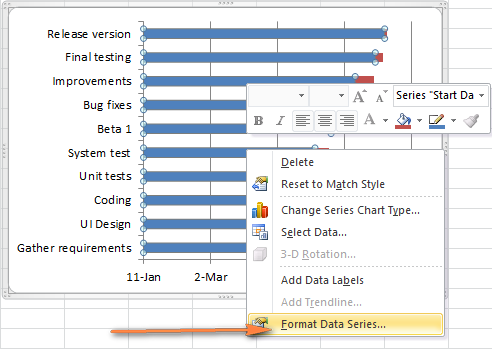
- The Format Data Series window will show up and you do the following:
- Switch to the Fill tab and select No Fill.
- Go to the Border Color tab and select No Line.

Note. You do not need to close the dialog because you will use it again in the next step.
- As you have probably noticed, the tasks on your Excel Gantt chart are listed in reverse order. And now we are going to fix this.Click on the list of tasks in the left-hand part of your Gantt chart to select them. This will display the Format Axis dialog for you. Select the Categories in reverse order option under Axis Options and then click the Close button to save all the changes.
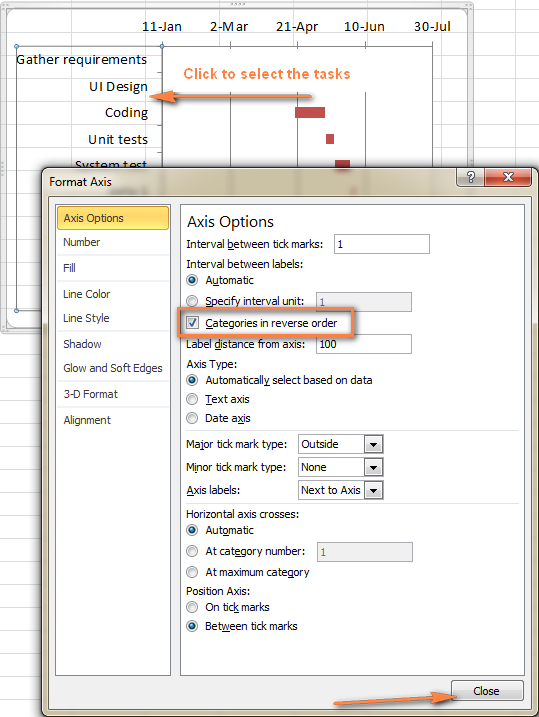
The results of the changes you have just made are:
- Your tasks are arranged in a proper order on a Gantt chart.
- Date markers are moved from the bottom to the top of the graph.
Your Excel chart is starting to look like a normal Gantt chart, isn't it? For example, my Gantt diagram looks like this now:

6. Improve the design of your Excel Gantt chart
Though your Excel Gantt chart is beginning to take shape, you can add a few more finishing touches to make it really stylish.
- Remove the empty space on the left side of the Gantt chart.As you remember, originally the starting date blue bars resided at the start of your Excel Gantt diagram. Now you can remove that blank white space to bring your tasks a little closer to the left vertical axis.
- Right-click on the first Start Date in your data table, select Format Cells > General. Write down the number that you see - this is a numeric representation of the date, in my case 41730. As you probably know, Excel stores dates as numbers based on the number of days since 1-Jan-1900. Click Cancel because you don't actually want to make any changes here.
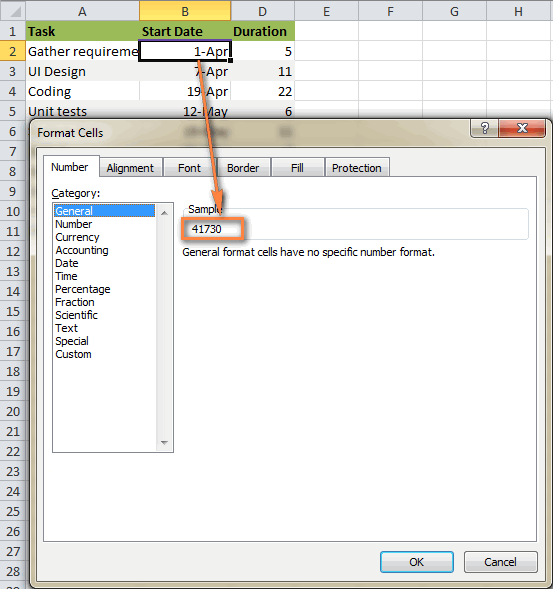
- Click on any date above the task bars in your Gantt chart. One click will select all the dates, you right click them and choose Format Axis from the context menu.
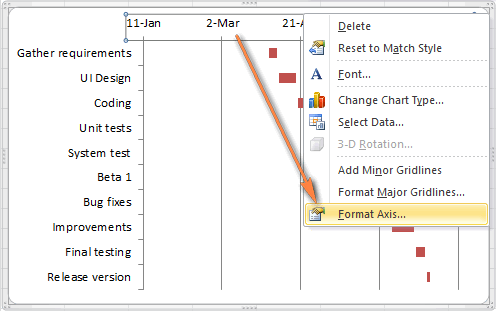
- Under Axis Options, change Minimum to Fixed and type the number you recorded in the previous step.
- Right-click on the first Start Date in your data table, select Format Cells > General. Write down the number that you see - this is a numeric representation of the date, in my case 41730. As you probably know, Excel stores dates as numbers based on the number of days since 1-Jan-1900. Click Cancel because you don't actually want to make any changes here.
- Adjust the number of dates on your Gantt chart. In the same Format Axis window that you used in the previous step, change Major unit and Minor unit to Fixed too, and then add the numbers you want for the date intervals. Typically, the shorter your project's timeframe is, the smaller numbers you use. For example, if you want to show every other date, enter 2 in the Major unit. You can see my settings in the screenshot below.
Note. In Excel 365, Excel 2021 - 2013, there are no Auto and Fixed radio buttons, so you simply type the number in the box.

Tip. You can play with different settings until you get the result that works best for you. Don't be afraid to do something wrong because you can always revert to the default settings by switching back to Auto in Excel 2010 and 2007, or click Reset in Excel 2013 and later.
- Remove excess white space between the bars. Compacting the task bars will make your Gantt graph look even better.
- Click any of the orange bars to get them all selected, right click and select Format Data Series.
- In the Format Data Series dialog, set Separated to 100% and Gap Width to 0% (or close to 0%).

And here is the result of our efforts - a simple but nice-looking Excel Gantt chart:
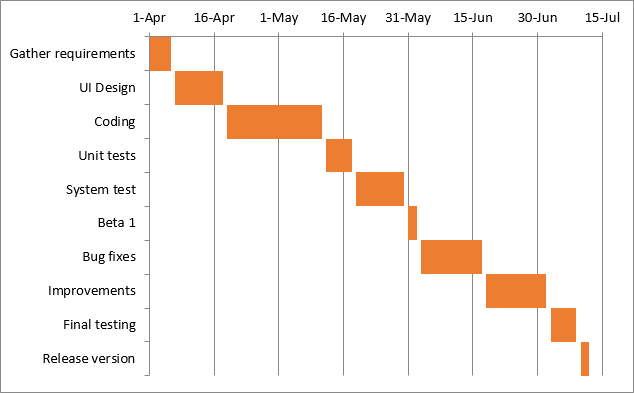
Remember, though your Excel chart simulates a Gantt diagram very closely, it still keeps the main features of a standard Excel chart:
- Your Excel Gantt chart will resize when you add or remove tasks.
- You can change a Start date or Duration, the chart will reflect the changes and adjust automatically.
- You can save your Excel Gantt chart as an image or convert to HTML and publish online.
Tips:
- You can design your Excel Gant chart in different ways by changing the fill color, border color, shadow and even applying the 3-D format. All these options are available in the Format Data Series window (right-click the bars in the chart area and select Format Data Series from the context menu).

- When you have created an awesome design, it might be a good idea to save your Excel Gantt chart as a template for future use. To do this, click the chart, switch to the Design tab on the ribbon and click Save as Template.
Excel Gantt chart templates
As you see, it's not a big problem to build a simple Gantt chart in Excel. But what if you want a more sophisticated Gantt diagram with percent-complete shading for each task and a vertical Milestone or Checkpoint line? Of course, if you are one of those rare and mysterious creatures whom we respectively call "Excel gurus", you can try to make such a graph on your own, with the help of this article: Advanced Gantt Charts in Microsoft Excel.
However, a faster and more stress-free way would be using an Excel Gantt chart template. Below you will find a quick overview of several project management Gantt chart templates for different versions of Microsoft Excel.
Gantt chart template for Microsoft Excel
This Excel Gantt chart template, called Gantt Project Planner, is purposed to track your project by different activities such as Plan Start and Actual Start, Plan Duration and Actual Duration as well as Percent Complete.
In Excel 2013 - 2021, just go to File > New and type "Gantt" in the Search box. If you cannot find it there, you can download it from Microsoft's web-site - Gantt Project Planner template. This template requires no learning curve at all, simply click on it and it's ready for use.
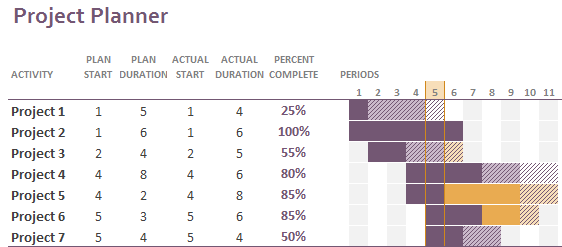
Online Gantt chart template
This is an Interactive Online Gantt Chart Creator from smartsheet.com. As well as the previous Gantt chart template, this one is fast and easy-to-use. They offer 30 days free trial, so you can sign with your Google account here and start making your first Excel Gantt diagram online straight away.
The process is very straightforward, you enter your project details in the left-hand table, and as you type a Gantt Chart is being built in the right-hand part of the screen.
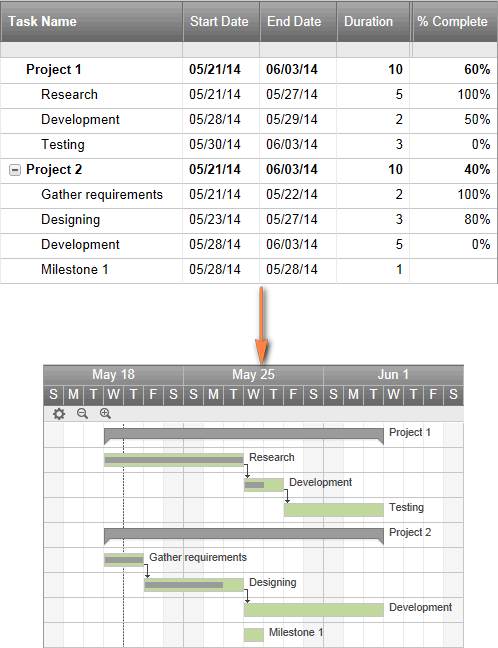
Gantt chart template for Excel, Google Sheets and OpenOffice Calc
Gantt chart template from vertex42.com is a free Gantt chart template that works with Excel as well as OpenOffice Calc and Google Sheets. You work with this template in the same fashion as you do with any normal Excel spreadsheet. Simply enter the start date and duration for each task and define % in the Complete column. To change the range of dates displayed in the Gantt chart area, slide the scroll bar.
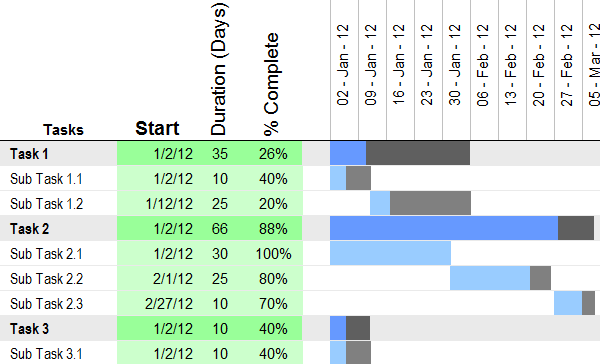
And finally, one more Gant chart Excel template for your consideration.
Project Manager Gantt Chart template
Project Manager Gantt Chart from professionalexcel.com is also a free project management Gantt chart template for Excel that can help track your tasks against their allocated time. You can choose either the standard weekly view or daily for short term projects.
Hopefully, at least one of the above-mentioned templates is suited for your needs. If not, you can create your own Gantt chart as demonstrated in the first part of this tutorial, and then save it as an Excel template.
Now that you are familiar with the main features of the Gantt diagram, you can explore it further and create your own sophisticated Gantt charts in Excel to amaze your boss and co-workers : )
Practice workbook for download
Gantt chart example (.xlsx file)
 by
by
426 comments
HI! Svetlana,
it's really explained very easily but i have only one concern while making it.
some bars aren't reaching to the month for which i have mentioned the end date.
example:- i have an activity ending in 20-May'21 but its bar is just reaching to Mar'21.
please support
Thank you very very much for this!
super fantastic! Free and easy to use! thank you so much.
Thank you..After 2 hours of brain ticking finally made my sheet with the help of your explanation..
Excellent! So nicely explained every detail along with reference to ready to use charts. Though I used the methods you explained and was able to get a nice Gantt Chart for a big project.
Thank you so much!
Thank you so much for making life easy for novice like us.
this is one of the best tutorial on gantt chart.
Gracias!
Well explained. You have made my assignment easy. Thank you
How do you put the dates on top but one cell equals one week?
Absolutely brilliant this walk through.
I'm chuffed with my Gantt chart.
Thanks for taking the time to make this page.
Thank you so much for this simple powerful tutorial.
Thank you very much for your help.
Keep up the good work!
Many thanks for this simple yet informative explanation - I have wasted a whole day looking at other versions but this is the easiest to follow.
Anne
Very Useful. Thank u
Thank you so much for this clear set of instructions on creating a Gantt chart! It has helped me immensely.
Nothing is difficult if one is capable for teaching. Thank you very much Svetlana.
Thanks Svetlana for this amazing tutorial!
I'm using Excel for Mac v16.34 and could easily follow your step-by-step guide.
I do have a couple of questions though:
a) The timeline follows a 7-day calendar week, but I need it to show a 5-day working week. How can this be done?
b) Is it possible to add a red vertical line that automatically indicates the current date?
Thank you for the step by step instructions along with the graphics. I Have not been on Excel for a few years and yet I could follow every step quite easily.
I do have a question. I am using your Gantt chart approach to display my ancestry, generation by generation for all seven generations on one page, therefore there are fourteen bars which represent the birth and ages of each generation. (The Tasks are people and the beginning dates are their birth dates and durations are ages.) After creating the Gantt chart all seven pairs (14 tasks) are blue. I would like to make the Males blue and the Females pink so people seeing the chart can see the flow of husbands and wives more easily across generations. But Excel does not allow conditional formatting (I do have a column for Sex(M and F)). I wondered if you had a straightforward solution? My other question is Can I put their ages at the end of each bar?
Thank you so much!!
Can you edit details after already saving your Gantt chart? For example, I tried to change the options from 30.0 yo 2.0 on the fixed Axis Options, but it vouldn't
Thank you very much for clear detailed instructions! You have saved me a lot of time!
Thank you very much, out of interest. Can you add a "completed" column which turns the duration cells to Green if you mark a "Yes" in the completed column?
Hi Sean Allen,
Sure. This can be easily done with conditional formatting. For the detailed information, please see Excel conditional formatting based on another cell value.
thank you so much for the tutorial, it's very interesting for any planner.
Thank you very much for this short massive tutorial, in fact it is simple but much helpful in my job activities. I need you to send me all the steps in an Microsoft.so that i will practice everyday during my free times.
Dear Svetlana,
it is a very helpfull Article but i think that there is a mistake at the End Date calculation formula. The formula is :
End Date = Start Date + Duration - 1 Because End Date is included in Activity Duration.
I think that spreadsheet might need recalculation.
I'm sorry for the mistakes but English is not my first language
Thank you
Hi Nick,
Thank you for your comment! In fact, End Dates are not needed for building a Gantt chart. I just explained how to calculate Duration if someone has Start Dates and End Dates.
I think you are right, I focused to the tree and I've lost the forest.
Thank you very much for this! One little question, If I want to show quarters instead of years (Q1,Q2,Q3,Q4) how would I do that? I have tried using 0.25 as MAJOR, this split my years in 4 quarters which is what I wanted but they were labelled ex.2020.25, 2020.5, 2020.75 etc.. How can I change this to label my year decimals as quarters?
Thank you!
Really helpful thanks!
YOU SAVED ME A LOT OF TIME. THANK YOU VERY MUCH! MAY GOD BLESS YOU & YOUR FAMILY.
HEY UR RIGHT
AMAZING AMAZING AMAZING!THANKS SO SO MUCH FOR THIS
Very nice, thanks man
Thanks
Gret
WHAT A NICE STEPS
I MAIL MY MAM BECAUSE I DON'T UNDERSTAND THIS BUT I HELPS ME
THKX .MALIKKKKKKKKKKKK
Thank you heaps!
Thanks for such a nice explanation. Keep it up. God bless you.
Really well played.
Thought the formation was a bit deep but our attacking prowess was exquisite.
4/10.
All the best
God bless
Frank Instein
Thank You, Very well explained.
How do you format it so that a same task is repeated throughout the project but is undertaken at different times. (i.e. multiple bars displayed for the same task at different dates across the page)
Thanks
Thank you for the step by step directions. Question. Is there a way to display multiple start/end dates on the same task on the same line. I don't want to see 12 lines, just 1 line with 12 durations. Example: Distribute material Jan 1-5, then again each month on the same days. So 12 blocks on 1 line/task with blanks in-between?
This is so detailed and was really helpful. Thanks.
This was so detailed and helpful. Really appreciate.
thank you very much... it was very helpful...
Thank you...
As others have said (but I have to reiterate because of how thankful I am), this is a fantastic help and so well explained. Thank you so much!
This is awesome and very helpful!
Thank you so much for such a nice way to guide us to learn Gantt Chart.
Thanks svetlana. I am also amazed by learning from yourself. Many many thanks to you.
very easy to follow, thanks a bunch
excellent, very clear...Thanks.
please try to use pictures for every step for better understanding.
Dear Svetlana,
Thanks for most simplified explaination. I have trouble in chart when I use 2 axis. One is Date and another is % compeletion of the project. In this my axis is not working great. So, the data for and chart is not matching. A to Z all Date axis has correct data but on secondary axis A to Z is showing data for % in Z to A.
Kindly support if possible.